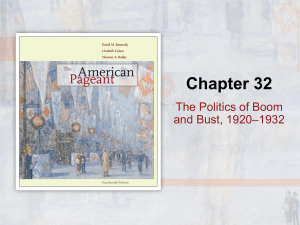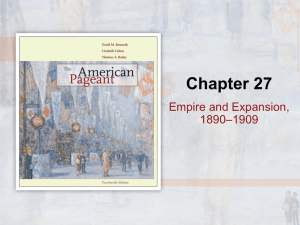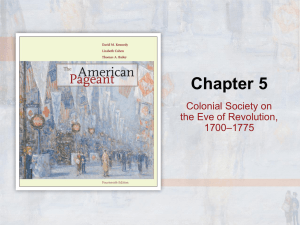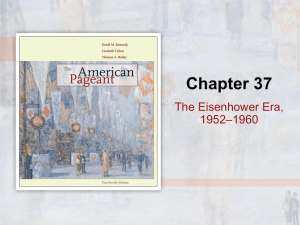MS Chapter 7 Powerpoint
advertisement
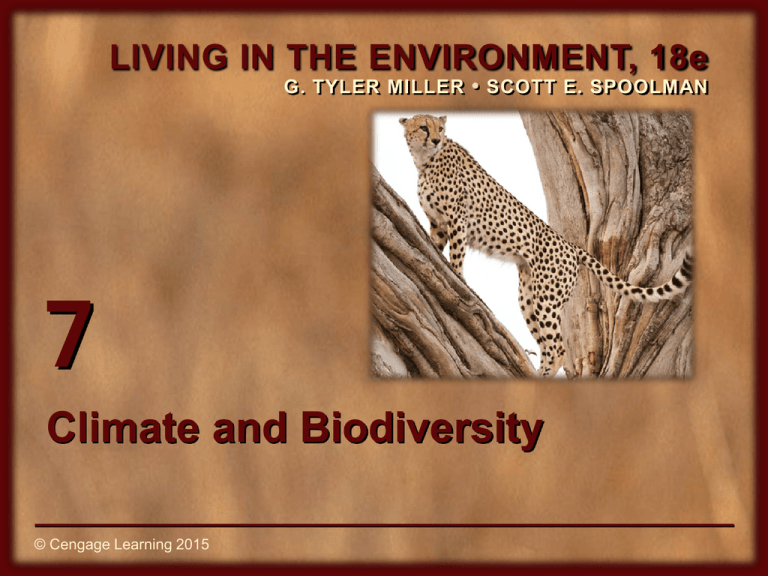
LIVING IN THE ENVIRONMENT, 18e G. TYLER MILLER • SCOTT E. SPOOLMAN 7 Climate and Biodiversity ©©Cengage CengageLearning Learning2015 2015 Core Case Study: A Temperate Deciduous Forest • Why do forests grow in some areas and not others? – Climate • Tropical • Polar • Temperate • Temperate deciduous forests – Globally more disturbed than any other ecosystem © Cengage Learning 2015 Three Major Climate Zones Fig. 7-1, p. 144 7-1 What Factors Influence Climate? • Key factors that determine an area’s climate – Incoming solar energy – The earth’s rotation – Global patterns of air and water movement – Gases in the atmosphere – The earth’s surface features © Cengage Learning 2015 The Earth Has Many Different Climates • Weather – Temperature, precipitation, wind speed, cloud cover – Hours to days • Climate – Area’s general pattern of atmospheric conditions over decades and longer © Cengage Learning 2015 The Earth Has Many Different Climates (cont’d.) Fig. 7-2, p. 145 The Earth Has Many Different Climates (cont’d.) • Ocean currents – Prevailing winds – Earth’s rotation – Redistribution of heat from the sun – Surface currents and deep currents © Cengage Learning 2015 The Earth Has Many Different Climates (cont’d.) • Air circulation in lower atmosphere due to – Uneven heating of the earth’s surface by sun – Rotation of the earth on its axis – Properties of air, water, and land © Cengage Learning 2015 The Earth Has Many Different Climates (cont’d.) Moist air rises, cools, and releases moisture as rain Polar cap Cold deserts Evergreen coniferous forest 60°N The highest solar energy input is at the equator. Westerlies 30°N Northeast trades Temperate deciduous forest and grassland Air cools and descends at lower latitudes. Hot desert Solar energy Tropical deciduous forest Equator Tropical rain forest Tropical deciduous forest Hot desert Southeast trades 30°S Westerlies 60°S Warm air rises and moves toward the poles. Temperate deciduous forest and grassland Cold deserts Air cools and descends at lower latitudes. Polar cap © Cengage Learning 2015 Fig. 7-3, p. 146 The Earth Has Many Different Climates (cont’d.) Warm, less salty, shallow current Cold, salty, deep current © Cengage Learning 2015 Fig. 7-5, p. 147 The Earth Has Many Different Climates (cont’d.) • El Niño-Southern Oscillation – Occurs every few years – Prevailing winds in tropical Pacific Ocean change direction – Affects much of earth’s weather for 1-2 years • What is the link between air circulation, ocean currents, and biomes? © Cengage Learning 2015 Greenhouse Gases Warm the Lower Atmosphere • Greenhouse gases – H2O – CO2 – CH4 – N2O • Natural greenhouse effect – Gases keep earth habitable • Human-enhanced global warming © Cengage Learning 2015 Earth’s Surface Features Affect Local Climates • Mountains interrupt flow of prevailing winds • Rain shadow effect – Most precipitation falls on the windward side of mountain ranges – Deserts leeward • Cities create microclimates © Cengage Learning 2015 Earth’s Surface Features Affect Local Climates (cont’d.) Prevailing winds pick up moisture from an ocean. On the windward side of a mountain range, air rises, cools, and releases moisture. On the leeward side of the mountain range, air descends, warms, and releases little moisture, causing rain shadow effect. Fig. 7-6, p. 148 7-2 How Does Climate Affect the Nature and Locations of Biomes? • Differences in average annual precipitation and temperature lead to the formation of tropical, temperate, and cold deserts, grasslands, and forests, and largely determine their locations © Cengage Learning 2015 Climate Helps Determine Where Organisms Can Live • Major biomes – Large land regions with certain types of climate and dominant plant life • Not uniform • Mosaic of patches • Change with latitude and elevation © Cengage Learning 2015 Climate Helps Determine Where Organisms Can Live (cont’d.) Cold Arctic tundra Evergreen coniferous forest Temperate desert Temperate deciduous forest Chaparral Hot Wet Cold desert Temperate grassland Tropical desert Tropical rain forest Dry Tropical grassland (savanna) Fig. 7-7, p. 149 Elevation Mountain ice and snow Tundra (herbs, lichens, mosses) Coniferous Forest Deciduous Forest Latitude Tropical Forest Tropical Forest Deciduous Forest Coniferous Forest Tundra (herbs, lichens, mosses) Polar ice and snow Stepped Art Fig. 7-8, p. 153 Climate Helps Determine Where Organisms Can Live (cont’d.) Fig. 7-9, p. 150 There Are Three Major Types of Deserts • Desert – annual precipitation low and often scattered through the year – Tropical deserts – Temperate deserts – Cold deserts • Why are deserts fragile ecosystems? © Cengage Learning 2015 There Are Three Major Types of Deserts (cont’d.) © Cengage Learning 2015 Fig. 7-10a, p. 150 There Are Three Major Types of Deserts (cont’d.) © Cengage Learning 2015 Fig. 7-10b, p. 150 There Are Three Major Types of Deserts (cont’d.) © Cengage Learning 2015 Fig. 7-10c, p. 150 There Are Three Major Types of Grasslands • Grasslands occur in: – Interior continents too moist for deserts and too dry for forests • Three main types: – Tropical – Temperate – Cold (arctic tundra) © Cengage Learning 2015 There Are Three Major Types of Deserts (cont’d.) © Cengage Learning 2015 Fig. 7-11a, p. 153 There Are Three Major Types of Deserts (cont’d.) © Cengage Learning 2015 Fig. 7-11b, p. 153 There Are Three Major Types of Deserts (cont’d.) © Cengage Learning 2015 Fig. 7-11c, p. 153 There Are Three Major Types of Grasslands (cont’d.) • Tropical – Savanna • Grazing animals • Browsing animals • Temperate – Cold winters and hot and dry summers – Tall-grass prairies – Short-grass prairies – Often converted to farmland © Cengage Learning 2015 There Are Three Major Types of Grasslands (cont’d.) © Cengage Learning 2015 Fig. 7-12, p. 154 There Are Three Major Types of Grasslands (cont’d.) • Arctic tundra – Plants close to ground to conserve heat – Most growth in short summer – Animals have thick fur – Permafrost • Underground soil that stays frozen • Alpine tundra – Above tree line in mountains © Cengage Learning 2015 There Are Three Major Types of Forests • • • • Forests – lands dominated by trees Tropical Temperate Cold – Northern coniferous and boreal © Cengage Learning 2015 There Are Three Major Types of Forests (cont’d.) © Cengage Learning 2015 Fig. 7-13a, p. 156 There Are Three Major Types of Forests (cont’d.) © Cengage Learning 2015 Fig. 7-13b, p. 156 There Are Three Major Types of Forests (cont’d.) © Cengage Learning 2015 Fig. 7-13c, p. 156 There Are Three Major Types of Forests (cont’d.) • Tropical rain forests – Hot and high moisture – Stratification of specialized plant and animal niches – Rapid recycling of scarce soil nutrients – What is the impact of human activities in the rain forest? © Cengage Learning 2015 There Are Three Major Types of Forests (cont’d.) Emergent layer Harpy eagle Height (meters) Toco toucan Understory Wooly opossum Brazilian tapir Black.crowned antpitta © Cengage Learning 2015 Canopy Shrub layer Ground layer Fig. 7-14, p. 157 There Are Three Major Types of Forests (cont’d.) • Temperate deciduous forests – Cooler temperature and less moisture – Broad-leaf deciduous trees – Slow rate of decomposition – What is the impact of human activities on temperate forests? © Cengage Learning 2015 There Are Three Major Types of Forests (cont’d.) • Evergreen coniferous forests: boreal and taigas – Cold winters – Few species of cone-bearing trees – Slow decomposition • Coastal coniferous forest, temperate rain forests – Found in scattered coastal regions © Cengage Learning 2015 Mountains Play Important Ecological Roles • Mountains – steep high elevation lands – Majority of the world’s forests – Islands of biodiversity – Habitats for endemic species – Help regulate the earth’s climate – Major storehouses of water • Role in hydrologic cycle © Cengage Learning 2015 Mountains Play Important Roles Mount Rainier National Park in Ecological Washington State (cont’d.) Fig. 7-16, p. 159 7-3 How Have Human Activities Affected the Word’s Terrestrial Ecosystems? • Human activities are disrupting ecosystem and economic services provided by many of earth’s deserts, grasslands, forests, and mountains © Cengage Learning 2015 Humans Have Disturbed Much of the Earth’s Land • About 60% of the world’s major terrestrial ecosystems are being degraded • The human ecological footprint is spreading across the globe © Cengage Learning 2015 Natural Capital Degradation Major Human Impacts on Terrestrial Ecosystems Deserts Large desert cities Destruction of soil and underground habitat by off-road vehicles Grasslands Conversion to cropland Release of CO2 to atmosphere from burning grassland Forests Mountains Clearing for agriculture, livestock grazing, timber, and urban development Conversion of diverse forests to tree plantations Agriculture Damage from offroad vehicles Air pollution blowing in from urban areas and power plants Depletion of groundwater Overgrazing by livestock Land disturbance and pollution from mineral extraction Oil production and off-road vehicles in Pollution of forest arctic tundra streams Timber and mineral extraction Hydroelectric dams and reservoirs Soil damage from off-road vehicles Fig. 7-17, p. 160 © Cengage Learning 2015 Fig. 7-18, p. 160 Size and Locations of Biomes Can Change • Biomes are not fixed – They change as the climate changes • Human activities are likely to affect biome placement in the future © Cengage Learning 2015 Size and Locations of Biomes Can Change (cont’d.) © Cengage Learning 2015 Fig. 7-19, p. 162 Three Big Ideas • Differences in climate: – Based on long-term differences in average temperature and precipitation – Largely determine the types and locations of the earth’s deserts, grasslands, and forests • The earth’s terrestrial systems provide important ecological and economic services © Cengage Learning 2015 Three Big Ideas (cont’d.) • Human activities are degrading and disrupting many of the ecological and economic services provided by the earth’s terrestrial ecosystems © Cengage Learning 2015 Tying It All Together: A Temperate Deciduous Forest and Sustainability • Climate plays a key role in determining the nature of terrestrial ecosystems • The earth’s dynamic climate system helps distribute heat from solar energy and recycle the earth’s nutrients • In nature, everything is connected © Cengage Learning 2015


